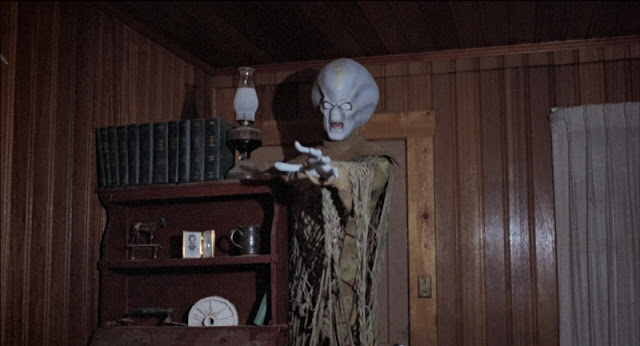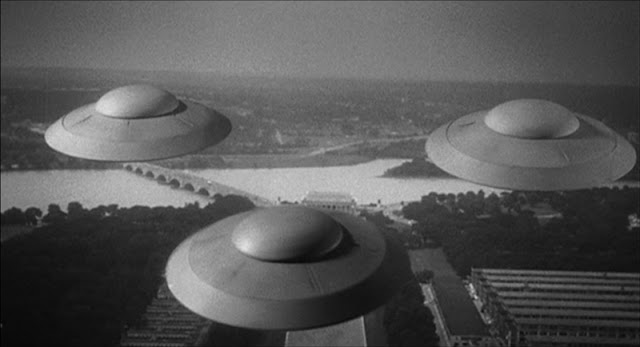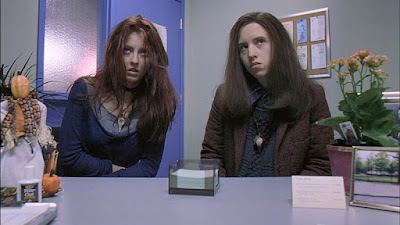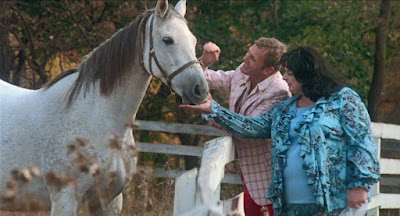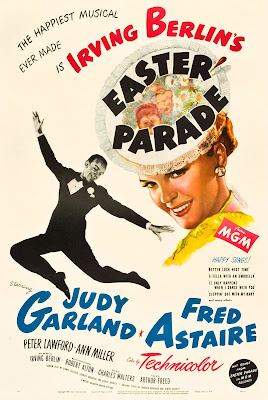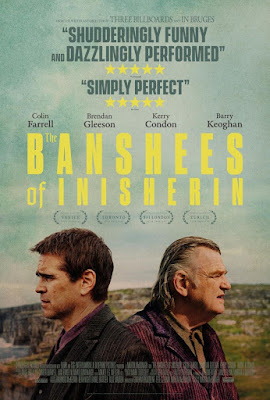(1980) Directed by Greydon Clark; Written by Lyn Freeman, Daniel Grodnik, Bennett Tramer and Steve Mathis; Starring: Jack Palance, Martin Landau, Tarah Nutter, Christopher S. Nelson, Cameron Mitchell, Neville Brand, Sue Ane Langdon, Ralph Meeker and Larry Storch; Available on Blu-ray and DVD
Rating: ***
I’m elated to participate, once again, in Brian Schuck’s (from Films Beyond the Time Barrier) “Favorite Stars in B Movies” blogathon. Be sure to check out all of the great entries! Today’s offering for Alien Invasion April is the little B-movie that could, Without Warning, featuring two Oscar winners and one nominee.
“…Makes perfect sense to me. They start out here in the country, they establish a foothold, and after they get us, they move in on the cities. That way they got a base to fight from. I’ll be damned if they get me without a fight. They’re not gonna get Sergeant Fred Dobbs easy. Not this time.” – Fred Dobbs (Martin Landau)
With a handful of notable exceptions (Forbidden Planet, 2001: A Space Odyssey), science fiction movies were once considered strictly B-movie fare before Lucas and Spielberg changed the landscape forever with their mega-budget spectacles. Amidst this paradigm shift, however, there was still a place for cheaper drive-in pictures. Director Greydon Clark’s ultra-low-budget sci-fi thriller Without Warning* was produced in December 1979 and released in Spring 1980. Shooting took place over a three-week period, in and around the Paramount Ranch area in Agoura Hills, California. Clark and crew adopted Halloween’s (1978) formula, with a sci-fi twist: a silent killer from outer space stalks and kills a group of unsuspecting teenagers. The film also appeared under the alternate title, It Came Without Warning, which especially sounds like the ‘50s B-movies that provided its inspiration.
* Fun Fact #1: The budget was reportedly $150,000, half of
which went to Palance and Landau’s salaries.
The opening scene sets the tone, when an awkward father/son hunting trip goes horribly wrong. The action shifts to four “teens” (played by actors well into their 20s) heading for a weekend of camping and frivolity. While refueling their van at a remote gas station, they encounter the creepy proprietor, Joe Taylor (Jack Palance). As is always the case, they ignore his warning to stay away from the local lake. It soon becomes apparent (surprise, surprise) that they’re being stalked by someone or something – a realization that becomes painfully clear when two of the teens, Sandy and Greg (Tarah Nutter and Christopher S. Nelson) stumble upon a shack where their dead companions are hanging on hooks. After a hasty retreat, they make their way to a nearby bar, where Greg’s story is met with skepticism by the patrons – except for Fred Dobbs (Martin Landau)*, a paranoid Vietnam veteran with an axe to grind. The situation takes a turn for the worse when Dobbs attempts to take matters into his own hands. Meanwhile, an unseen assailant is lurking about in the woods, searching for its next victim.
* Fun Fact #2: According to Nutter, she screamed so loudly during the shack scene that the walls, which were made of flimsy cardboard-like material, collapsed, necessitating a quick rebuild.
** Fun Fact #3: Landau’s character was named after Humphrey
Bogart’s character from Treasure of the Sierra Madre (1948). Like his
namesake, he becomes more unhinged as the movie progresses.
Despite the miniscule budget, Greydon Clark took steps to make his movie look like a more expensive production. His ace-in-the-hole was renowned cinematographer Dean Cundey (in his fifth and final collaboration with Clark), who was fresh off his work with Halloween (1978). Cundey utilized hand-held Steadicam shots to simulate the alien’s point of view, and employed a fog machine to provide a reflective surface for the night shots. Keeping in mind the production’s limitations, Clark wisely chose not to reveal the alien until much later in the film. Instead, its presence is implied through shadows and its signature weapon,* floppy flying creatures (resembling something like a cross between a pancake and a sand dollar)** that immobilize its victims. Only Taylor, a seasoned hunter, has the presence of mind to do something about the pesky flying parasites, while everyone else in the movie just passively allows them to suck their blood. The alien***/**** was played by 7-foot-2-1/2-inch performer Kevin Peter Hall, who would go on to play Harry from Harry and the Hendersons, as well as the titular creature from Predator (which is frequently compared to this film for its many similarities).
* Fun Fact #4: In the original script, the alien used a bow and arrows.
** Fun Fact #5: Closeups of the flying creatures were shot during post-production, in Clark’s garage, with a three-person crew.
*** Fun Fact #6: The alien head was created by Rick Baker.
**** Fun Fact #7: The trumpet of an elephant was used for
the alien’s final screech.
There’s some nice chemistry between Nutter and Nelson, who hold their own against veterans Palance and Landau. Although Sandy starts out as the typical screaming damsel in distress, she shows some backbone by the end of the film, during the final confrontation. While obviously attracted to her, Greg manages to keep his hormones in check long enough to do the right thing and provide emotional support to the visibly traumatized Sandy.
Jack Palance and Martin Landau seem to be enjoying
themselves, playing characters that are, respectively, crazy and crazier. The
more we learn about Taylor, the saner he becomes. He believes Sandy and Greg,
but with a healthy dose of skepticism. It becomes clear that he knows about the
alien and its habits, but he’s a loner, used to doing things his way, without
the input or interference of other people. In typical Palance fashion, he
hisses his lines with conviction with a self-aware gleam in his eyes. Dobbs, on
the other hand, wants an audience, no matter how deranged his ramblings might
sound. His paranoia reaches a zenith when he suspects Greg and Sandy are aliens
that have assumed the shape of humans. Landau nearly crosses the line into
self-parody with his over-the-top performance, yet he somehow reins his role in
just enough to remain credible.
Besides the headliners, the cast of Without Warning is a who’s who of veteran character actors. Cameron Mitchell (who becomes the film’s first victim) appears as a macho, alpha male father on a hunting trip with his reluctant 20-something son. Ralph Meeker (in his final film role) and Neville Brand add some color as a pair of bar patrons, and Sue Ane Langdon enjoys some brief time in the spotlight as Aggy, the spunky bartender. Larry Storch (F-Troop) provides a little comic relief as a befuddled scout master.* Besides the old pros, there’s veteran-actor-to-be David Caruso, in one of his first film roles, as a horny teenager (guess how he ends up).
* Fun Fact #8: According to Clark, one of the crew members
volunteered her son’s scout troop for the movie.
Without Warning wouldn’t be a proper B-movie without the requisite genre clichés, including a cat appearing from nowhere to provide a jump scare, someone saying “This place gives me the creeps,” a vehicle that inexplicably fails to start, and a virginal final girl. In the unintentionally hilarious final confrontation, try not to facepalm as the alien gives the surviving protagonists every opportunity to destroy it, conveniently standing motionless while Sandy fiddles with a detonator. For his part, Taylor forgets everything he’s learned about hunting, running out in the open, yelling “Alien! Alien!” As silly as it can be at times, it’s fair to acknowledge that Without Warning walked so Predator could run. Sure, it’s as rough around the edges as origami made by kindergarteners, but that’s part of its charm. This was made quickly and on the cheap. The fact that it’s entertaining as well is only icing on the bloody cake.
Sources for this article: Blu-ray commentary by Greydon
Clark; Featurette: “Greg and Sandy’s Alien Adventures: interviews with Actors
Tarah Nutter and Christopher S. Nelson”; Featurette: “Independents Day with
Dean Cundey”; Featurette: “Producers vs. Aliens: Interview with Co-writer/Co-Producer
Daniel Grodnik”




